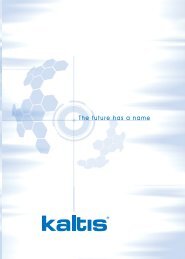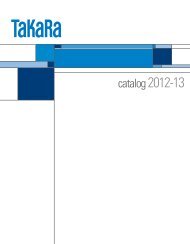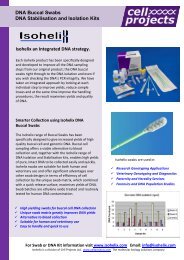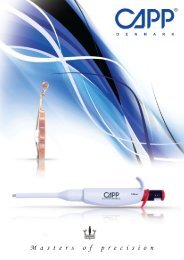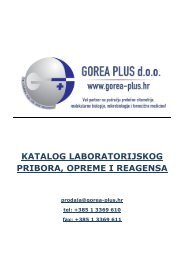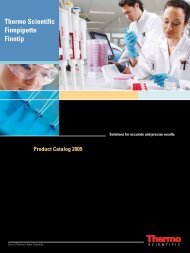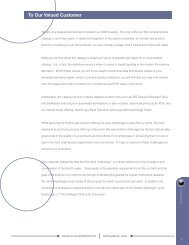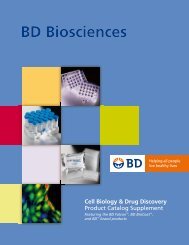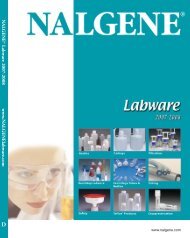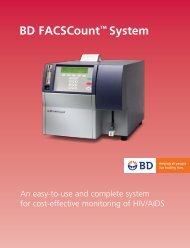NEW - Gorea plus doo
NEW - Gorea plus doo
NEW - Gorea plus doo
- No tags were found...
You also want an ePaper? Increase the reach of your titles
YUMPU automatically turns print PDFs into web optimized ePapers that Google loves.
Always with updated information - www.nuncbrand.comChemical Resistance Chart Nunc LabwareAdditional InformationInterpretation ofChemical ResistanceThe Chemical Resistance Chart thatfollows is a general guide only. Becauseso many factors can affect the chemicalresistance of a given product, you shouldtest under your own conditions.Effects of Chemicals on PlasticsChemicals can affect the strength,flexibility, surface appearance, color,dimensions or weight of plastics. Thebasic modes of interaction which causethese changes are: (1) chemical attackon the polymer chain, with resultantreduction in physical properties,including oxidation; reaction offunctional groups in or on the chain;and depolymerization; (2) physicalchange, including absorption of solvents,resulting in softening and swelling of theplastic; permeation of solvent throughthe plastic; dissolution in a solvent; and(3) stress cracking from the interactionof a “stress cracking agent” with internalor external stresses. Also see “ChemicalResistance Classification.”Mixing and/or dilution of certain chemicalsin Nunc labware can be potentiallydangerous.The reactive combination of differentchemicals or compounds of two ormore classes may cause an undesirablechemical effect or result in an increasedtemperature, which can affect chemicalresistance (as temperature increases,resistance to attack decreases). Otherfactors affecting chemical resistanceinclude pressure and internal or externalstresses (e.g. centrifugation), lengthof exposure, and concentra tion of thechemical.EnvironmentalStress CrackingEnvironmental stress cracking is the failureof a plastic material in the presenceof certain types of chemicals.This failure is not a result of chemicalattack. Simultaneous presence of threefactors causes stress cracking: tensilestress, a stress cracking agent and theinherent susceptability of the plastic tostress cracking.Common stress cracking agents aredetergents, surface active chemicals,lubricants, oils, ultra-pure water andplating additives such as brighteners andwetting agents. Relatively small concentrationsof stress cracking agent may besufficient to cause cracking.Mixing and/or dilution of certain chemicalsmay result in reactions whichproduce heat, which can cause productfailure.Pre-test your specific usage and alwaysfollow correct lab safety procedures.CautionDo not store strong oxidizing agents in plasticlabware except that made of TEFLON FEP orPFA. Prolonged exposure causes the material tobecome brittle.We have included a number of resins, which arenot used in Nunc Brand products, as we feel thatcustomers may find the information useful.Resin Codes:ACL Acetal (polyoxymethylene)ECTFE Halar ECTFE (ethylene-chlorotrifluoroethylenecopolymer)ETFE Tefzel ETFE (ethylene-tetrafluoroethylene)FEP TEFLON FEP (fluorinated ethylene propylene)HDPE High-density polyethyleneLDPE Low-density polyethyleneNYL Nylon (polyamide)PC PolycarbonatePETG Polyethylene terephthalate copolymerPFA TEFLON PFA (perfluoroalkoxy)PMMA Polymethyl methacrylate (acrylic)Resin Codes:PPPolypropylenePPCO* Polypropylene copolymerPSPolystyrenePSF PolysulfonePUR PolyurethanePVDF Polyvinylidene fluorideTFE TEFLON TFE (tetrafluoroethylene)TMX ThermanoxTPE Thermoplastic elastomerPMX PermanoxXLPE Cross-linked high-density polyethylene*PPCO has replaced polyallomer (PA) in all products.188



